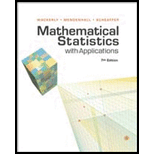In this context, Y1,Y2,...,Yn1 denotes a random sample from the population having normal distribution with unknown mean μ1 and variance σ2, X1,X2,...,Xn2 denotes a random sample from the population having normal distribution with unknown mean μ2 and variance σ2, and W1,W2,...,Wn3 denotes a random sample from the population having normal distribution with unknown mean μ3 and variance σ2.
The likelihood ratio test has to be obtained for the following hypothesis:
H0:σ12=σ22=σ32versusHa: At least one inequality
Likelihood ratio test:
A likelihood ratio test of H0:Θ∈Ω0 versus Ha:Θ∈Ω^a denotes λ as the test statistic and the rejection region as λ≤k.
The test statistic, λ, is denoted as follows:
λ=L(Ω^0)L(Ω^)=maxΘ∈Ω^0L(Ω^0)maxΘ∈Ω^L(Ω^)
The likelihood function, L(Ω0), is given below:
L(Ω0)=∏i=1n1f(Yi,μ1,σ2)×∏j=1n2f(Xj,μ2,σ2)×∏m=1n3f(Wm,μ2,σ2)=∏i=1n112πσ1e−(Yi−μ1)22σ12×∏j=1n212πσ2e−(Xi−μ2)22σ22×∏m=1n312πσ3e−(Wi−μ3)22σ32=(12π(σ1+σ2+σ3))n1+n2+n3×e−12σ12∑i=1n1(Yi−μ1)2×e−12σ22∑j=1n2(Xi−μ2)2×e−12σ32∑m=1n3(Wi−μ3)2
Let, σ1=σ2=σ3=σ
L(Ω0)=(12π(σ))n1+n2+n3×e−12σ2∑i=1n1(Yi−μ1)2×e−12σ2∑j=1n2(Xi−μ2)2×e−12σ2∑m=1n3(Wi−μ3)2=(12π(σ))n1+n2+n3×e−12σ2[∑i=1n1(Yi−μ1)2+∑j=1n2(Xi−μ2)2+∑m=1n3(Wi−μ3)2]
Since the above model is a complete model with parameters (μ,σ), just the sample size has increased to n1+n2+n3.
Under H0:σ12=σ22=σ32, the likelihood function is as follows:
L(Ω0)=(12π(σ))n1+n2+n3×e−12σ2∑i=1n1(Yi−Y¯)2×e−12σ2∑j=1n2(Xi−X¯)2×e−12σ2∑m=1n3(Wi−W¯)2
MLE of θ is obtained as given below:
l=−(n1+n2+n3)2 ln(σ2)−12σ2∑i=1n1(Yi−μ1)2−12σ2∑j=1n2(Xi−μ2)2−12σ2∑m=1n3(Wi−μ3)2
Differentiate MLE with respect to θ.
dldσ2=−(n1+n2+n3)2σ2 −12σ4∑i=1n1(Yi−μ1)2−12σ4∑j=1n2(Xi−μ2)2−12σ4∑m=1n3(Wi−μ3)2
Equate dldθ=0,
−(n1+n2+n3)2σ2 −12σ4∑i=1n1(Yi−μ1)2−12σ4∑j=1n2(Xi−μ2)2−12σ4∑m=1n3(Wi−μ3)2=012σ4[∑i=1n1(Yi−μ1)2+∑j=1n2(Xi−μ2)2+∑m=1n3(Wi−μ3)2]=(n1+n2+n3)2σ2[∑i=1n1(Yi−μ1)2+∑j=1n2(Xi−μ2)2+∑m=1n3(Wi−μ3)2]=2σ4(n1+n2+n3)2σ2[∑i=1n1(Yi−μ1)2+∑j=1n2(Xi−μ2)2+∑m=1n3(Wi−μ3)2]=σ2(n1+n2+n3)
Thus, the value of σ2 is obtained as follows:
σ2=1n1+n2+n3[∑i=1n1(Yi−Y¯)2+∑j=1n2(Xi−X¯)2+∑m=1n3(Wi−W¯)2]σ2=T2
The likelihood function is as follows:
L(Ω0)=(1(2πT)n1+n2+n3)×e−12T2∑i=1n1(Yi−Y¯)2×e−12T2∑j=1n2(Xi−X¯)2×e−12T2∑m=1n3(Wi−W¯)2=(1(2πT)n1+n2+n3)×e−12[∑i=1n1(Yi−Y¯)2+∑j=1n2(Xi−X¯)2+∑m=1n3(Wi−W¯)2T2]=(1(2πT)n1+n2+n3)×e−12[n1+n2+n3]
The likelihood function, L(Ω), is given below:
L(Ω)=∏i=1n1f(Yi,μ1,σ2)×∏j=1n2f(Xj,μ2,σ2)×∏m=1n3f(Wi,μ2,σ2)=∏i=1n112πσ2e−(Yi−μ1)22σ2×∏j=1n212πσ2e−(Xi−μ2)22σ2×∏m=1n312πσ2e−(Wi−μ3)22σ2=(12πσ2)n1+n2+n3×e−12σ2∑i=1n1(Yi−μ1)2×e−12σ2∑j=1n2(Xi−μ2)2×e−12σ2∑m=1n3(Wi−μ3)2
Since the above model is a complete model with parameters (μ,σ), just the sample size has increased to n1+n2+n3.
Define:
T22=∑j=1n2(Xj−X¯)2n1(Note: T22 is the MLE's of σ22)
Similarly, one can write for T1,T3.
The likelihood function is as follows:
L(Ω)=(1(2π)n1+n2+n3(T1n1T2n2T3n3))×e−12T12∑i=1n1(Yi−μ1)2×e−12T22∑j=1n2(Xj−X¯)2×e−12T32∑m=1n3(Wi−μ3)2=(1(2π)n1+n2+n3(T1n1T2n2T3n3))×e−n12×e−n22×e−n32=(1(2π)n1+n2+n3(T1n1T2n2T3n3))×e−12[n1+n2+n3]
The likelihood ratio test for testing H0:σ12=σ22=σ32 versus Ha:Atleast one inequality is obtained as given below:
λ=L(Ω^0)L(Ω^)=(1(2πT)n1+n2+n3)×e−12[n1+n2+n3](1(2π)n1+n2+n3(T1n1T2n2T3n3))×e−12[n1+n2+n3]=(T1n1T2n2T3n3Tn1+n2+n3)
Now, the rejection region becomes as follows:
λ≤k(T1n1T2n2T3n3Tn1+n2+n3)≤k(n1 ln T1+n2 ln T2+n3 ln T3)−(n1+n2+n3)ln T≤ln k(n1 ln T1+n2 ln T2+n3 ln T3)−(n1+n2+n3)ln T>k1.
Here, ln k=k1, where k1 is some constant.
Therefore, the rejection region will be in the form of RR:{(n1 ln T1+n2 ln T2+n3 ln T3)−(n1+n2+n3)ln T>k1} for some constant k1.

